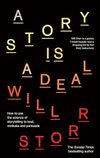A Story is a Deal: How to use the science of storytelling to lead, motivate and persuade
amazon.com
Saved by Brandon Marcus and
A Story is a Deal: How to use the science of storytelling to lead, motivate and persuade

Saved by Brandon Marcus and
When writing a persuasive story, it’s useful to begin composing our intended takeaway message as an atomic statement. What is the single, specific learning we’d like our audience to remember? This should be the focus and the theme of our story:
For the German poet Friedrich von Schlegel, they have ‘the greatest quantity of thought in the smallest space’; while for the literary scholar Dr Andrew Hui, they ‘have an atomic quality – compact yet explosive’. In these respects, they recall phrases such as ‘sour
‘When hundreds or thousands of individuals and subgroups possess not only a mental image of the future, but the same mental image, they can more easily coalesce to realise a collective achievement.’ These rules should be applied everywhere possible in our storytelling. We should strive to be specific, concrete and sensory when we define our values,
... See moreWhenever we’re telling stories, then, we should use concrete, specific and sensory language to allow our audience to imagine properly the world we’re creating and transport them into it.
To be maximally persuasive, it’s best to obey the law of simplicity. One hero, one story, one message.
Trey Parker, co-creator of the hugely successful animated series South Park, argues that scenes or ‘beats’ in a story should only ever be connected with a therefore or a but. ‘If the words “and then” belong between your beats, you’re fucked, basically,’ he has said. ‘You’ve got something pretty boring. What should happen between every beat is
... See moreSuccessful stories begin with a moment of change that incites surprise and curiosity, hijacking the brain’s need for prediction. And that’s how they should continue – with moments of unexpected change that are causally linked: one scene of change triggering the next, which triggers the next, and so on until the final scene.
We use inferences about causality to tell sense-making stories about the world.
Emotional moments in story tend to happen when we identify with a character, and that character then experiences peak moments in their struggle against obstacles in pursuit of the goals of survival, connection and status. We emotionally connect to characters who feel in some way like people-like-us, understanding and responding to the world in the
... See more